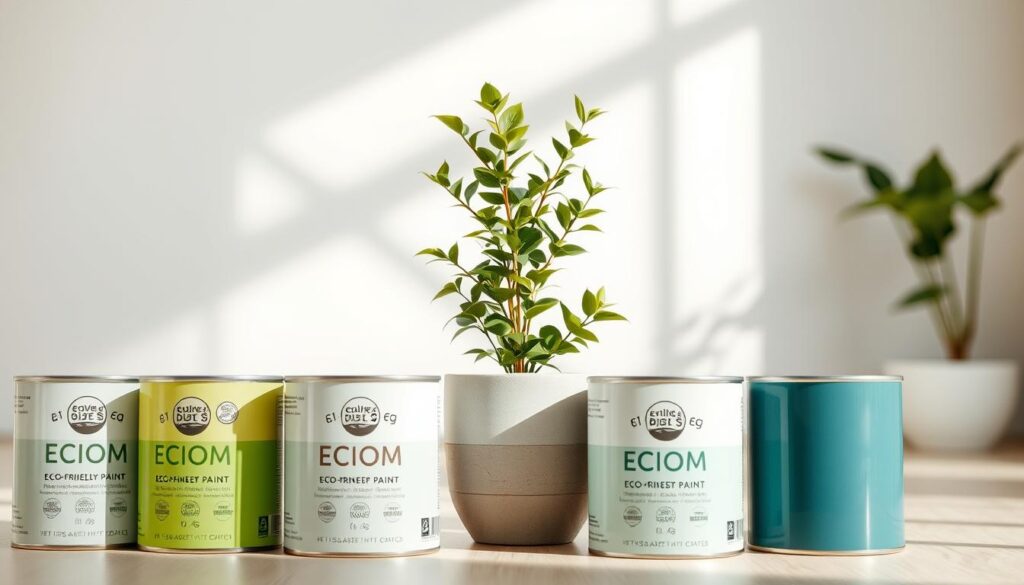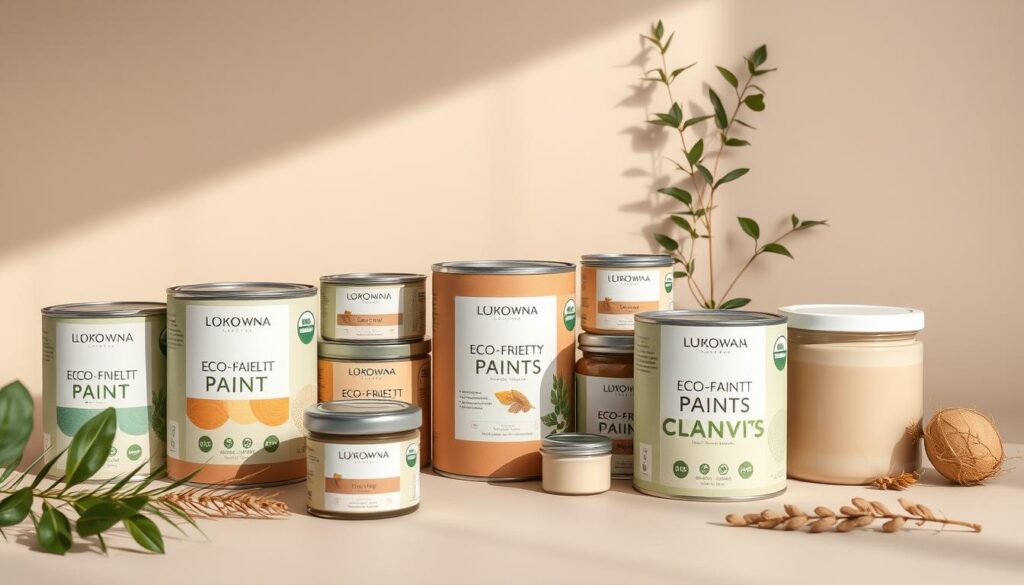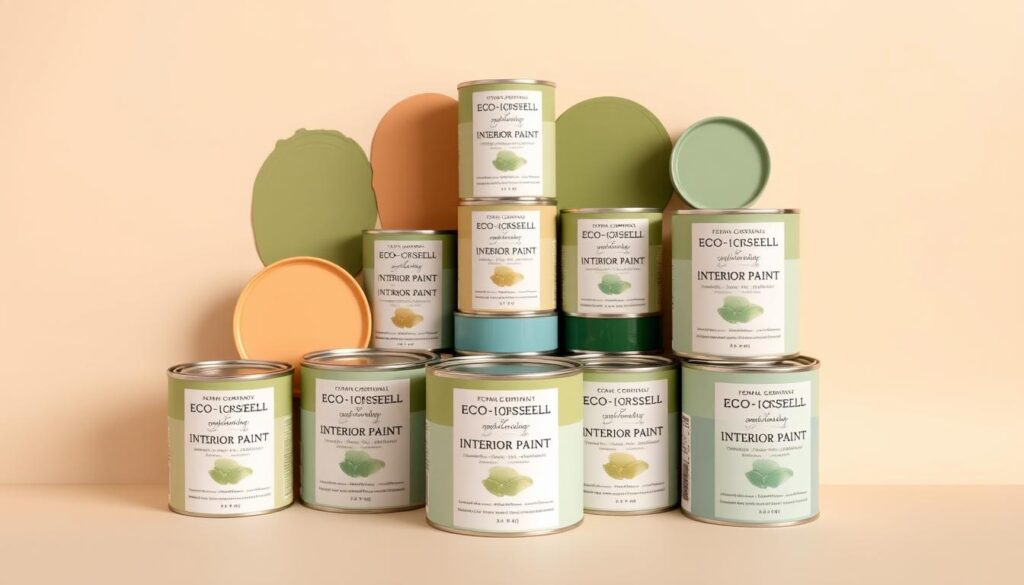Are you aware of the impact your paint choices have on the environment and your health? When refreshing your home, considering the sustainability of your interior finishes is crucial. Luckily, the market now offers a wide range of sustainable products, with wall paints having numerous eco-friendly options.
The importance of selecting the right paint cannot be overstated, as it affects not only the aesthetic appeal of your home but also the air quality and the planet. You can now opt for eco-friendly paints without compromising on quality, coverage, or colour options.
This guide will help you navigate the world of eco-friendly paints, understanding their benefits, what to look for in terms of credentials, and practical considerations. By making informed choices, you can benefit both your home environment and the wider planet.
Key Takeaways
- Understand the importance of eco-friendly paint for your home and the environment.
- Learn what makes a paint eco-friendly and the benefits it offers.
- Discover top UK brands offering eco-friendly paints.
- Find out what credentials to look for when selecting an eco-friendly paint.
- Get practical tips on applying and maintaining eco-friendly paints.
Understanding Eco-Friendly Interior Paints
When it comes to interior painting, the type of paint you choose can affect not just the aesthetic, but also the air quality and ecological balance. As a homeowner, it’s essential to understand the differences between eco-friendly paints and their conventional counterparts.
What Makes Paint Eco-Friendly?
Eco-friendly interior paints are made with ingredients that have a lower environmental impact. These paints typically have lower or zero Volatile Organic Compounds (VOCs), which are harmful chemicals that can cause health issues and air pollution. The production process of eco-friendly paints also tends to be more sustainable, using natural ingredients and minimizing waste.
- Low or zero VOCs
- Natural ingredients
- Sustainable production process
The Environmental Impact of Conventional Paints
Conventional paints, on the other hand, contain high levels of VOCs and other harmful chemicals. These paints can lead to indoor air pollution, negatively affecting your health and wellbeing. Furthermore, the production and disposal of conventional paints have a significant environmental impact, contributing to air pollution and waste management issues.
Key Benefits of Choosing Eco-Friendly Interior Paints
Selecting eco-friendly interior paints is a step towards a healthier living environment. By choosing these paints, you not only enhance the aesthetic appeal of your home but also contribute to a more sustainable future.
Health Advantages for Your Family
Using eco-friendly paints can significantly reduce the risk of health issues associated with conventional paints. These paints are typically free from harmful chemicals and volatile organic compounds (VOCs), creating a safer indoor environment for you and your family. Eco-friendly paints are especially beneficial for households with members who have allergies or respiratory conditions.
Moreover, eco-friendly paints are often water-based, making them easier to clean up with soap and water, eliminating the need for harsh thinners or cleaners. This not only saves you time but also reduces exposure to toxic substances.
Environmental Benefits
The environmental advantages of eco-friendly paints are substantial. These paints are designed to have a lower environmental impact, from production to disposal. By choosing eco-friendly paints, you reduce the amount of waste sent to landfills and minimize the release of pollutants into the environment. Eco-friendly paint production typically uses less energy and generates fewer emissions, further reducing its carbon footprint.

Additionally, many eco-friendly paint brands prioritize sustainable sourcing and local production, which helps in reducing the overall environmental impact. By supporting these brands, you are promoting a more circular economy in the paint industry.
Essential Eco-Credentials to Look For
When selecting eco-friendly interior paints, it’s crucial to understand the key eco-credentials that make a paint truly sustainable. As you navigate the market, you’ll come across various labels and certifications that can be confusing. However, focusing on a few critical credentials can simplify your decision-making process.
VOC Levels Explained
Volatile Organic Compounds (VOCs) are chemicals released by paints that can affect indoor air quality. Low-VOC or VOC-free paints are essential for maintaining a healthy indoor environment. These paints reduce the emission of harmful chemicals, making them a safer choice for your family. When shopping, always check the VOC levels on the label.
B Corp Certification
B Corp Certification is a prestigious recognition that a company meets rigorous standards for social and environmental responsibility. Eco-friendly paint brands with this certification have demonstrated a commitment to sustainability and ethical practices. Look for this certification when choosing a paint brand to ensure you’re supporting a company that prioritizes the environment.
Vegan-Friendly Formulations
Vegan-friendly paints are made from plant-based materials and natural minerals, avoiding animal-derived ingredients. To verify if a paint is vegan-friendly, check with the manufacturer, as not all vegan products display a vegan logo. Some natural paint brands proudly advertise their vegan formulations, making it easier for you to make an informed choice. Ingredients like casein, shellac, and animal bone derivatives are commonly found in non-vegan paints, so it’s essential to read labels carefully.
By focusing on these essential eco-credentials, you can make a more informed decision when choosing interior paints that are not only good for your home but also for the environment.
Top Eco-Friendly Paint Brands in the UK
For homeowners seeking sustainable painting solutions, several UK-based brands stand out for their commitment to eco-friendliness. These brands offer a range of options from premium to more accessible, ensuring there’s something for every budget and preference.
Premium Options: Farrow & Ball and Little Greene
Farrow & Ball is renowned for its high-quality, eco-friendly paints. Their products are low in VOCs and made from natural ingredients. Little Greene, on the other hand, offers a range of eco-friendly paints with low VOC levels and water-based formulations.
Both brands are known for their excellent coverage and durability. Farrow & Ball’s Edward Bulmer range is particularly notable for its rich pigments and sustainable production methods.
| Brand | VOC Levels | Coverage |
|---|---|---|
| Farrow & Ball | Low | Excellent |
| Little Greene | Low | Excellent |
Specialist Eco Brands: COAT and Lick
COAT and Lick are specialist brands that have gained recognition for their commitment to sustainability. COAT offers a range of eco-friendly paints with a focus on natural ingredients and minimal waste. Lick is known for its durable, water-based paints that are free from harmful chemicals.
“Using natural materials and minimizing waste are key principles for us. Our paints are designed to be both beautiful and sustainable.” – COAT spokesperson
Accessible Options: Dulux Evolve and ECOS
Dulux, a well-established brand in the UK, offers the Evolve range, which includes paints made with 35% recycled content. This innovation significantly reduces waste in the paint industry. ECOS Paints, an American brand available in the UK, offers over 1300 shades and uses a unique pigmenting system that avoids harmful colours or ingredients.

Both Dulux Evolve and ECOS Paints provide eco-friendly options that are more accessible to mainstream consumers due to their wider distribution and competitive pricing. They offer a balance between affordability and environmental responsibility.
| Brand | Recycled Content | Pricing |
|---|---|---|
| Dulux Evolve | 35% | Competitive |
| ECOS Paints | N/A | Competitive |
Practical Considerations When Choosing Eco-Friendly Interior Paints
When selecting eco-friendly interior paints, several practical considerations come into play to ensure you make the best choice for your home. You need to consider not just the environmental benefits, but also how the paint performs in real-world conditions.
Coverage and Performance
Eco-friendly paints have made significant strides in terms of coverage and performance. Modern formulations ensure that you don’t need to compromise on quality. For instance, some eco-friendly paints are designed to provide excellent coverage with just one coat, making them as effective as their conventional counterparts.
Application Differences
The application process for eco-friendly paints can differ slightly from traditional paints. Some may require specific primers or have specific drying times. Understanding these differences is crucial for a smooth application process.
Maintenance and Durability
Eco-friendly paints are designed to be durable and easy to maintain. Many are fully washable and resistant to stains, making them perfect for high-traffic areas like kitchens and children’s rooms. Regular maintenance is still necessary to keep them looking their best.
Conclusion: Making the Right Choice for Your Home
Ultimately, selecting eco-friendly interior paints is about creating a healthier home and reducing your environmental footprint. When making your final selection, balance factors like budget, performance needs, and environmental priorities. Consider the longevity of your colour choices and how they fit into broader sustainable home improvement approaches. Look beyond VOC levels to the full environmental impact of your paint choices and support companies with genuine sustainability commitments.
By choosing eco-friendly paint, you’re making a positive choice for both your living environment and the planet. Your individual consumer choices collectively drive positive change in the paint industry. Perhaps, lowering your consumption and picking colours that last might be the greatest impact you can have.



